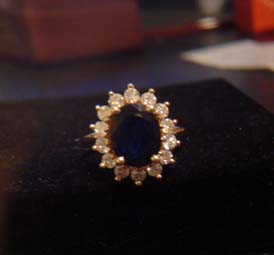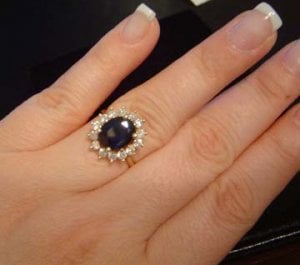Richard Sherwood
Ideal_Rock
- Joined
- Sep 25, 2002
- Messages
- 4,924
The GIA & AGL both have recognized color and clarity grading systems for colored stones. The AGL (American Gem Laboratories) has a cut grading system as well, and the AGL certificate is highly respected among gem dealers. The SSEF report put out by the Gubelin lab in Switzerland is highly regarded, and has made groundbreaking progress in describing such things as the level of glass resin filling present in a stone on a scale from minor to moderate to significant, as well as indicating (like several labs do) the presence or absence of heat treatment.
Although the GIA has a very helpful colored stone grading system, as far as I know they don't use it on their reports. The AGTA lab (American Gem Trade Association) puts out a respected report, but as far as I know they are similar to the GIA in that they don't put out a quality analysis on their reports. The Gubelin report I'm not sure of, but haven't seen any with a "quality" analysis.
I use the GIA's system on my reports for color/clarity, and then my own analysis regarding cut. The GIA system, properly used, will go a long way towards conveying the overall quality of a gem. The AGL system does the same thing, using a little different terminology.
The GIA system breaks down the color description into (3) components: Hue, Tone & Saturation.
Hue: Root body color
Modifier: Secondary modifying hue(s), on a scale ranging from "very slight to strong", (ie "strongly purplish Red", abbreviated stpR)
Tone: Light to Dark on a scale of 1 to 10
0- colorless or white
1- extremely light
2- very light
3- light
4- medium light
5- medium
6- medium dark
7- dark
8- very dark
9- extremely dark
10- black
Saturation: How pure or desaturated by gray or brown the hue is on a scale of 1 to 6- Vivid (6), Strong (5), Moderately Strong (4), Very Slightly Grayish or Brownish (3), Slightly Grayish or Brownish (2), Grayish or Brownish (1)
Clarity is desribed in a similar manner to diamonds, with this distinction. They recognize that different types of minerals typically crystallize in heavier or lesser included states. For example, Aquamarine typically crystallizes in relatively clear crystals, while Emerald or Red Tourmaline typically crystallizes in relatively included (imperfect) crystals.
Therefore, they adjust the clarity grading system in three types-
Type 1: Typically crystallizes inclusion free (such as aquamarine & topaz)
Type 2: Typically crystallizes included (such as ruby, sapphire & garnet)
Type 3: Almost always crystallizes included (such as emerald & red tourmaline)
The Type 1 category is graded almost similarly to diamond clarity, while the Type 2 and Type 3 categories are supported by a "handicap" system. In other words, a VS quality emerald will be a "clearish" clarity, but nowhere near as clear as a VS clarity aquamarine.
The different types are then clarity graded with the familiar, although slightly modified clarity terms used in diamond clarity grading:
Clarity
VVS- very, very slightly included
VS- very slightly included
SI1- slightly included, first class
SI2- slightly included, second class
I1- included (imperfect), first class
I2- included (imperfect), second class
I3- included (imperfect), third class
DeClasse'- stones not transparent because of inclusions
The AGL lab uses a similar system with different terminology:
Flawless- eyeclean
LI1- lightly included, first class
LI2- lightly included, second class
MI1- moderately included, first class
MI2- moderately included, second class
HI1- heavily included, first class
HI2- heavily included, second class
EI1- severely included, first class
EI2- severely included, second class
EI3- severely included, third class (DeClasse')
Note- The AGL does not use the three Type category system which GIA uses.
Cut, or Make SGL grades cut on a categorized system of:
Exceptional
Very Good
Good
Fair
Poor
Most "native cut" stones fall in the "fair" category, with some ranging from fair to good or fair to poor. Usually when you see a very good or exceptionally cut stone, it was cut in Israel, Europe or the United States. Note- A "fair" native cut stone can often be quite beautiful, lacking only the preciseness of cutting which is often typical of the precision consciousness of Israeli, European & Western cutters. Richard Homer and the German Idar Oberstein precision cutters would be an extreme example of this "cut consciousness".
Brilliance
This is another aspect of make which is graded when examining the a colored stone:
Brilliance how much of the surface area "returns light" or "shows color".
Extinction how much of the surface area "absorbs light" or "goes dark".
Windowing how much of the surface area "leaks light", creating a "window" through the stone.
Using these established parameters, a gemologist can usually convey the "fineness" of a gem to an extent that another gemologist or savvy consumer would be able to recognize it. Multiple photographs from different angles and under different lighting conditions are also helpful, although nothing substitutes for an actual visual inspection.
Although the GIA has a very helpful colored stone grading system, as far as I know they don't use it on their reports. The AGTA lab (American Gem Trade Association) puts out a respected report, but as far as I know they are similar to the GIA in that they don't put out a quality analysis on their reports. The Gubelin report I'm not sure of, but haven't seen any with a "quality" analysis.
I use the GIA's system on my reports for color/clarity, and then my own analysis regarding cut. The GIA system, properly used, will go a long way towards conveying the overall quality of a gem. The AGL system does the same thing, using a little different terminology.
The GIA system breaks down the color description into (3) components: Hue, Tone & Saturation.
Hue: Root body color
Modifier: Secondary modifying hue(s), on a scale ranging from "very slight to strong", (ie "strongly purplish Red", abbreviated stpR)
Tone: Light to Dark on a scale of 1 to 10
0- colorless or white
1- extremely light
2- very light
3- light
4- medium light
5- medium
6- medium dark
7- dark
8- very dark
9- extremely dark
10- black
Saturation: How pure or desaturated by gray or brown the hue is on a scale of 1 to 6- Vivid (6), Strong (5), Moderately Strong (4), Very Slightly Grayish or Brownish (3), Slightly Grayish or Brownish (2), Grayish or Brownish (1)
Clarity is desribed in a similar manner to diamonds, with this distinction. They recognize that different types of minerals typically crystallize in heavier or lesser included states. For example, Aquamarine typically crystallizes in relatively clear crystals, while Emerald or Red Tourmaline typically crystallizes in relatively included (imperfect) crystals.
Therefore, they adjust the clarity grading system in three types-
Type 1: Typically crystallizes inclusion free (such as aquamarine & topaz)
Type 2: Typically crystallizes included (such as ruby, sapphire & garnet)
Type 3: Almost always crystallizes included (such as emerald & red tourmaline)
The Type 1 category is graded almost similarly to diamond clarity, while the Type 2 and Type 3 categories are supported by a "handicap" system. In other words, a VS quality emerald will be a "clearish" clarity, but nowhere near as clear as a VS clarity aquamarine.
The different types are then clarity graded with the familiar, although slightly modified clarity terms used in diamond clarity grading:
Clarity
VVS- very, very slightly included
VS- very slightly included
SI1- slightly included, first class
SI2- slightly included, second class
I1- included (imperfect), first class
I2- included (imperfect), second class
I3- included (imperfect), third class
DeClasse'- stones not transparent because of inclusions
The AGL lab uses a similar system with different terminology:
Flawless- eyeclean
LI1- lightly included, first class
LI2- lightly included, second class
MI1- moderately included, first class
MI2- moderately included, second class
HI1- heavily included, first class
HI2- heavily included, second class
EI1- severely included, first class
EI2- severely included, second class
EI3- severely included, third class (DeClasse')
Note- The AGL does not use the three Type category system which GIA uses.
Cut, or Make SGL grades cut on a categorized system of:
Exceptional
Very Good
Good
Fair
Poor
Most "native cut" stones fall in the "fair" category, with some ranging from fair to good or fair to poor. Usually when you see a very good or exceptionally cut stone, it was cut in Israel, Europe or the United States. Note- A "fair" native cut stone can often be quite beautiful, lacking only the preciseness of cutting which is often typical of the precision consciousness of Israeli, European & Western cutters. Richard Homer and the German Idar Oberstein precision cutters would be an extreme example of this "cut consciousness".
Brilliance
This is another aspect of make which is graded when examining the a colored stone:
Brilliance how much of the surface area "returns light" or "shows color".
Extinction how much of the surface area "absorbs light" or "goes dark".
Windowing how much of the surface area "leaks light", creating a "window" through the stone.
Using these established parameters, a gemologist can usually convey the "fineness" of a gem to an extent that another gemologist or savvy consumer would be able to recognize it. Multiple photographs from different angles and under different lighting conditions are also helpful, although nothing substitutes for an actual visual inspection.













300x240.png)